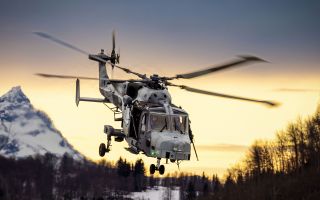Royal Navy helps Ukrainians prepare for huge task of clearing mines from Black Sea
A large multinational exercise designed to help Ukraine deal with the threat of Russian sea mines is taking place off the coast of northwest Scotland.
Hosted by the Royal Navy, two Ukrainian minehunters are involved in Exercise Sea Breeze along with ships from five Nato countries including France, Germany and Estonia, plus personnel from 13 allied nations.
Russia is believed to have laid more than 500 naval mines in the Black Sea as part of President Vladimir Putin's efforts to blockade Ukrainian ports.
Clearing them will be a monumental task and much of it will fall to the crews of Ukrainian minesweepers Chernihiv and Cherkasy.
The two-week exercise aims to help them prepare for a post-war era in the Black Sea as they practise searching for mines, operating alongside Nato navies.
"The Black Sea now is one of the most dangerous seas in the world," said Commodore Dmytro Kovalenko, the head of training command in the Ukrainian navy.
"The amount of mines that Russia has used in our waters has made it absolutely impossible to use for civilian and military shipment and training."
Chernihiv and Cherkasy were originally Royal Navy ships – the Sandown-class minehunters HMS Shoreham and HMS Grimsby – but were transferred to the Ukrainian navy last year.
They have glass-reinforced plastic hulls to reduce their magnetic signature and extend their lifespan.
On board is a decompression chamber for the ships' mine clearance divers and a sonar that can identify an object the size of a football from a kilometre away.
Despite all the kit, it is still a dangerous business.
Commodore Steve Banfield, of the Maritime Capability Development Coalition for Ukraine, told Forces News: "Minehunting is really an art form and is really complicated.
"It's a bit like trying to play 3D chess because you're looking for an object through a body of water which you can't see through, only by sound. You are interpreting sonar pictures.
"Once you have an idea that you may have a mine, you then have to use your autonomous, uncrewed system skills in order to go down an investigate that contact to determine whether it is a threat.
"You then have to figure out the best way to dispose of that mine – and that may be with an uncrewed system, or you may have to put divers in the water."
SeaFox is one of the autonomous systems the Royal Navy is training the Ukrainians to use.
The remotely operated submersible goes down, identifies and then blows up underwater mines, if need be.
For now, these Ukrainian minehunters cannot reach the Black Sea as the Montreux Convention, signed in 1936, means Turkey can block access through the Bosphorus Strait to any warship during a time of war.
But these Ukrainian sailors hope one day to return and – as a future part of Nato – begin the job of de-mining the dangerous waters of the Black Sea.









